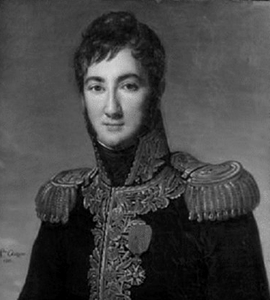General Joseph-Claude-Marie Charbonnel

Born: March 24, 1775
Place of Birth: Dijon, Côte-d'Or, France
Died: March 10, 1846
Place of Death: Paris, France
Arc de Triomphe: CHARBONNEL on the west pillar
Pronunciation:
After entering the artillery school of Châlons in October of 1792 as a sous-lieutenant, Joseph-Claude-Marie Charbonnel graduated and left the school as a lieutenant in May of 1793. Four months later in September he joined the 2nd Foot Artillery and then he went on to serve at the Siege of Lyon and the Siege of Toulon . Charbonnel took part in the defense of isles of Hyères and then in February of 1794 he was promoted to capitaine. Next he was sent to the Army of Italy where he took part in the attack of Saorgio. After joining the Army of the Rhine, Charbonnel took part in the Siege of Luxembourg in May of 1795 and then in 1796 he joined the Army of the Sambre and Meuse. Charbonnel went on to serve in the Siege of Ehrenbreitstein and then at the crossing of the Rhine at Neuwied in April of 1797.
In 1798 Charbonnel joined the Army of the Orient for the expedition to Egypt. On the way there he served at Malta and after arriving he fought at Alexandria, Chebreiss, and the Battle of the Pyramids . At the Battle of the Pyramids, General Bonaparte promoted Charbonnel to chef de bataillon. Next Charbonnel was sent to Cairo to command the artillery and then he was ordered to prepare the defenses of the mouth of the Nile. Getting sick with ophthalmia, he set sail for Europe but enroute he was captured by pirates and taken to Janina. While there Charbonnel was cured of ophthalmia and he escaped and made his way to Corfu, only to be arrested there and sent to Constantinople. After four months he was sent back to France, and then he was sent on a mission to meet with Ali Pasha.
Back in France again, Charbonnel served with the 8th Horse Artillery in 1801 and then the 1st Foot Artillery in 1802. In 1803 he became major in that regiment before he took command of the artillery of the camp of Bruges. In June of 1804 Charbonnel was promoted to colonel of the 6th Horse Artillery and then as the army prepared for war in 1805 Charbonnel became the chief of staff of artillery of Marshal Davout's III Corps. He served throughout the 1805 campaign and then in 1806 he served at the Battle of Auerstadt against Prussia. Charbonnel continued to serve and took part in the crossings of the Oder and Vistula Rivers and then in December he was ordered to construct the bridges over the Narew. Next he took part in the crossing of the Bug where he was wounded in the knee, and then in February of 1807 he served at the Battle of Eylau. As the campaign resumed later that year, Charbonnel took part in the Battle of Heilsberg and then commanded the artillery at Koenigsberg.
In 1808 Charbonnel was named a Baron of the Empire and he remained as the chief of staff of artillery of III Corps. When Austria attacked in 1809, he took part in the Danube campaign, serving at Thann, Abensberg, Eckmühl, and Ratisbon in April, Aspern-Essling in May, and then at Wagram in July. That October Charbonnel was promoted to général de brigade. In November of 1809 Charbonnel was sent to Spain to take command of the artillery of V Corps, and then in September of 1810 he took command of the artillery of Marshal Ney's VI Corps. In this position Charbonnel served at the sieges of Ciudad-Rodrigo and Almeida, the Battle of Bussaco , and the fighting at Coimbre, Pombal, Mirando de Corvo, Foz d'Arunce, and the Battle of Fuentes de Onoro . He was wounded at the Fort of the Conception and afterwards he returned to France.
In January of 1812 Charbonnel took command of the artillery school at Grenoble but then in February he was named chief of staff of artillery of the Grande Armée, serving under General Lariboisière. He took part in the campaign in Russia, serving at Witepsk, the crossing of the Dnieper, and the Battle of Borodino. Charbonnel survived the retreat and was promoted to général de division in January of 1813 and then in March he took command of the artillery of Marshal Ney's III Corps. He went on to fight at Weissenfels, Lützen, Bautzen, and Goerlitz. That October Charbonnel fought at the Battle of Leipzig where he was wounded in the hip by an explosion of a caisson. Nevertheless, he stayed with the army and in January of 1814 he took command of the artillery of II Corps. During the defense of France of 1814, Charbonnel served at La Chaussée, Montereau , Les Moulineaux, La Ferté-sous-Jouarre, and Arcis-sur-Aube.
After Napoleon's abdication in April of 1814 and Bourbon Restoration, Charbonnel was named inspector general of the 5th arrondissement of artillery. When Napoleon resumed power in 1815 for the Hundred Days, Charbonnel took command of the artillery of the 13th military division. For the remainder of the Hundred Days he commanded the artillery of the Army of the Alps under Marshal Suchet, and afterwards he continued to lead a distinguished career.
Bibliography
Related Pages:
Updated August 2016
© Nathan D. Jensen